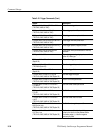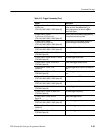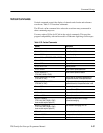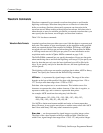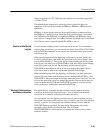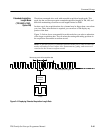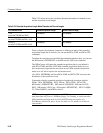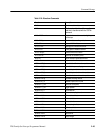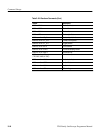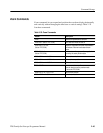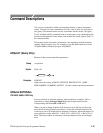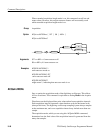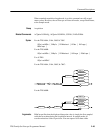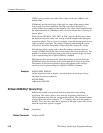
Command Groups
2–42
TDS Family Oscilloscope Programmer Manual
Table 2–23 below shows the correlation between the number of channels in use
and the waveform record length.
Table 2–23: Extended-Acquisition-Length Mode Channels and Record Lengths
# of Channels in Use Extended Acquisition Length Waveform Record Length
1 of 4
(not on the TDS 520C and 724C)
8 M samples 500 K samples
2 of 4
(or on the TDS 520C and 724C: 1 of 2)
4 M samples 250 K samples
3 or 4 of 4
(or on the TDS 520C and 724C: 2 of 2)
2 M samples 100 K samples
From a software development viewpoint, to define how much of the extended
acquisition length data to include, you can use the DATa:STARt and DATa:STOP
commands.
To define the waveform record within the extended acquisition data, you can use
the HORizontal:RECORDSTART or the HORizontal:POSition command.
The CURVe? query will return the extended acquisition data as you defined it
with DATa:STARt and DATa:STOP. With extended-acquisition-mode set to on,
this can be much larger than the waveform record. With extended-acquisition-
mode set to off, this is equal to the waveform record.
Also, DATa RECORDSNAp will force DATa:STARt and DATA:STOP to become the
boundaries of the waveform record.
Commands related to extended-acquisition-length mode operations include:
CURVe, DATa RECORDSNAp, DATa SOUrce, DATa:STARt, DATa:STOP,
HORizontal:ACQDURATION?, HORizontal:ACQLENGTH, HORizontal:EXTĆ
DACQ, HORizontal:POSition, HORizontal:RECORDSTART, RECAll:ACQDAĆ
TA, SAVe:ACQDATA, and WFMPre:<wfm>?.
NOTE. Extended-acquisition-length mode CURVe? queries can easily return
more data than will fit on a 1.44 Mbyte floppy. For example, to return an entire
8 M extended acquistion mode record in ASCII format can require over
26.8 Mbytes of hard disk space. It can also take over 25 minutes to do this on
some models.



